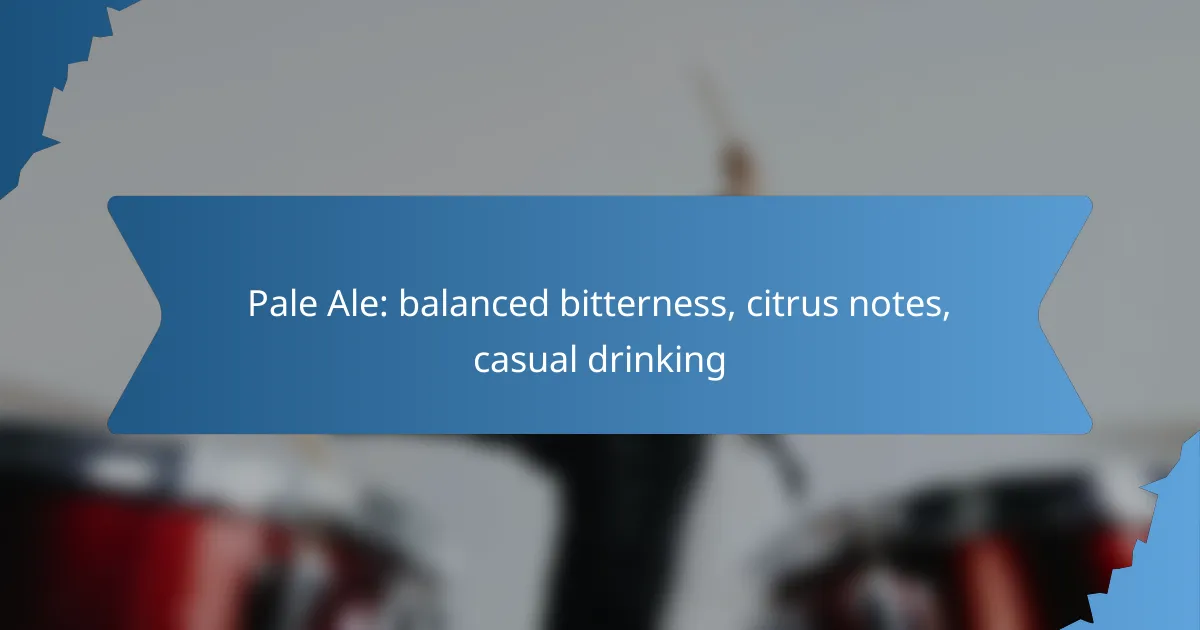Pale ale is celebrated for its balanced bitterness, often enhanced by refreshing citrus and floral notes. This combination makes it a popular choice for casual drinking, appealing to a wide range of palates. Whether enjoyed at a gathering or during a relaxed evening, pale ales offer a delightful experience that is both approachable and flavorful.

What are the best pale ales available in Australia?
Australia offers a diverse range of pale ales, each with unique flavor profiles and characteristics. The best options balance bitterness with citrus notes, making them ideal for casual drinking.
Stone & Wood Pacific Ale
Stone & Wood Pacific Ale is renowned for its refreshing taste and tropical fruit aromas. This pale ale features a light body with a subtle bitterness, making it perfect for warm Australian days.
With an ABV around 4.4%, it’s easy to enjoy multiple servings without overwhelming your palate. The combination of Galaxy and Ella hops contributes to its signature citrus and passionfruit notes.
Little Creatures Pale Ale
Little Creatures Pale Ale is a classic choice among Australian craft beers, known for its balanced flavor and hoppy aroma. It typically has an ABV of 5.2%, providing a moderate strength that appeals to many beer enthusiasts.
This ale showcases a blend of American hops, delivering a citrusy profile complemented by a biscuity malt backbone. It’s a versatile option that pairs well with a variety of foods.
Balter XPA
Balter XPA stands out with its vibrant hop character and refreshing finish. With an ABV of around 5%, it strikes a nice balance between flavor and drinkability.
This extra pale ale features tropical fruit flavors and a hint of bitterness, making it an excellent choice for casual gatherings. Its crispness makes it particularly enjoyable during outdoor activities.
Coopers Pale Ale
Coopers Pale Ale is a well-established favorite, offering a rich, malty flavor with a touch of fruity hop aroma. With an ABV of about 4.5%, it’s a sessionable beer suitable for various occasions.
This ale is bottle-conditioned, which adds to its unique character and slight cloudiness. It pairs well with hearty dishes, enhancing the overall dining experience.
James Squire Pale Ale
James Squire Pale Ale is known for its smooth, well-rounded taste and a hint of caramel sweetness. With an ABV of approximately 5.0%, it provides a satisfying drinking experience without being too heavy.
The blend of Cascade and Galaxy hops gives it a pleasant citrus aroma, making it a popular choice among casual drinkers. It’s versatile enough to complement a wide range of foods, from grilled meats to spicy dishes.

How to choose a pale ale for casual drinking?
Choosing a pale ale for casual drinking involves considering flavor, alcohol content, and local options. Look for a brew that balances bitterness with citrus notes, making it refreshing and easy to enjoy in social settings.
Consider flavor profile
The flavor profile of a pale ale is crucial for casual drinking. Look for options that offer a balanced bitterness complemented by citrus or fruity notes, which enhance the overall drinking experience. Many pale ales have a moderate hop presence, making them approachable for a wide range of palates.
When sampling different brands, pay attention to the aroma and taste. A pale ale with hints of grapefruit, orange, or lemon can be particularly refreshing, especially during warmer months. Consider trying a flight of different pale ales to find your preferred flavor combination.
Check alcohol content
Alcohol content is an important factor when selecting a pale ale for casual drinking. Most pale ales typically range from around 4.5% to 6.5% ABV (alcohol by volume), which allows for enjoyable sipping without overwhelming effects. If you plan to drink several, opt for those on the lower end of the scale.
Be mindful of your own tolerance and the drinking context. For social gatherings, a pale ale with moderate alcohol content can help maintain a relaxed atmosphere while still providing flavor and enjoyment.
Look for local breweries
Exploring local breweries can enhance your pale ale experience. Many craft breweries offer unique takes on the style, often using local ingredients that reflect regional flavors. This not only supports local businesses but also provides an opportunity to discover new favorites.
Check out brewery tours or tasting events in your area to sample a variety of pale ales. Engaging with local brewers can also give you insights into their brewing process and flavor inspirations, making your casual drinking experience more enriching.

What are the flavor characteristics of pale ale?
Pale ale is known for its balanced bitterness, often complemented by citrus and floral notes, making it a popular choice for casual drinking. The interplay of these flavors creates a refreshing and approachable beer style that appeals to a wide range of palates.
Balanced bitterness
The hallmark of pale ale is its balanced bitterness, typically derived from hops. This bitterness usually falls within the range of 30 to 50 International Bitterness Units (IBUs), providing a crisp finish without overwhelming the palate.
When selecting a pale ale, look for those with a harmonious blend of malt sweetness and hop bitterness. This balance is crucial; too much bitterness can detract from the overall enjoyment, while too little may result in a lackluster flavor profile.
Citrus and floral notes
Pale ales often feature vibrant citrus and floral notes, primarily from the hop varieties used during brewing. Common citrus flavors include grapefruit, orange, and lemon, which contribute to the beer’s refreshing quality.
These aromatic qualities can vary significantly based on the hop selection. For example, American hops like Cascade and Citra are known for their bold citrus characteristics, while European varieties may impart more subtle floral aromas. This diversity allows for a wide range of flavor experiences within the pale ale category.
Malt sweetness
The malt backbone of pale ale provides a counterbalance to the bitterness and hop flavors. This malt sweetness is typically moderate, contributing notes of caramel, toffee, or biscuit, which enhance the overall complexity of the beer.
When tasting a pale ale, pay attention to how the malt sweetness interacts with the bitterness and hop flavors. A well-crafted pale ale will have a smooth, rounded mouthfeel that supports the other flavor components without dominating them.

What food pairs well with pale ale?
Pale ale’s balanced bitterness and citrus notes make it a versatile choice for food pairings. It complements a variety of dishes, enhancing flavors and creating enjoyable dining experiences.
Grilled meats
Grilled meats are an excellent match for pale ale, as the beer’s bitterness cuts through the richness of the meat. Consider pairing it with burgers, sausages, or grilled chicken, where the smoky flavors harmonize with the ale’s citrus undertones. A pale ale can elevate the taste of marinated meats, especially those with a hint of sweetness or spice.
Spicy dishes
Pale ale pairs well with spicy dishes, as its hoppy bitterness can balance heat while enhancing flavor. Dishes like spicy tacos, buffalo wings, or Thai curry benefit from the refreshing qualities of the beer. When selecting a pale ale, opt for one with a moderate hop profile to avoid overpowering the dish.
Cheese platters
Cheese platters are another great pairing for pale ale, particularly with sharp or tangy cheeses. Varieties like cheddar, gouda, or blue cheese complement the beer’s citrus notes. For a balanced experience, include some crackers or fruits on the platter to enhance the overall flavor profile.

What are the brewing techniques for pale ale?
Pale ale brewing techniques focus on achieving a balanced bitterness and distinct citrus notes. Key methods include selecting appropriate malts, employing specific hopping techniques, and controlling fermentation temperatures to enhance flavor profiles.
Use of pale malts
Pale malts are the foundation of pale ale, providing a light color and a subtle sweetness. Typically, brewers use pale malt as the primary grain, often complemented by small amounts of caramel or crystal malts to add complexity. This combination results in a malt backbone that supports the hop character without overpowering it.
When selecting pale malts, consider the origin and type, as they can influence the final flavor. For instance, English pale malts tend to impart a biscuity quality, while American pale malts may offer a cleaner, crisper taste.
Hopping methods
Hopping methods are crucial for defining the bitterness and aroma of pale ale. Brewers often use a combination of bittering hops added early in the boil and aroma hops added later to preserve their volatile oils. This technique creates a layered hop profile that balances bitterness with citrus and floral notes.
Dry hopping is another popular method, where hops are added during fermentation or conditioning. This technique enhances aroma without significantly increasing bitterness, making it ideal for achieving the desired flavor in pale ales.
Fermentation temperature
Fermentation temperature plays a vital role in the development of flavors in pale ale. Most brewers ferment at temperatures ranging from 18°C to 22°C (64°F to 72°F) for ales, which allows for the production of fruity esters and phenols that complement the hop character. Higher temperatures can lead to more pronounced fruity flavors, while lower temperatures may result in a cleaner profile.
It’s essential to monitor fermentation closely, as fluctuations can affect the final taste. Maintaining a consistent temperature helps ensure that the yeast performs optimally, contributing to the overall balance of bitterness and citrus notes in the finished beer.
